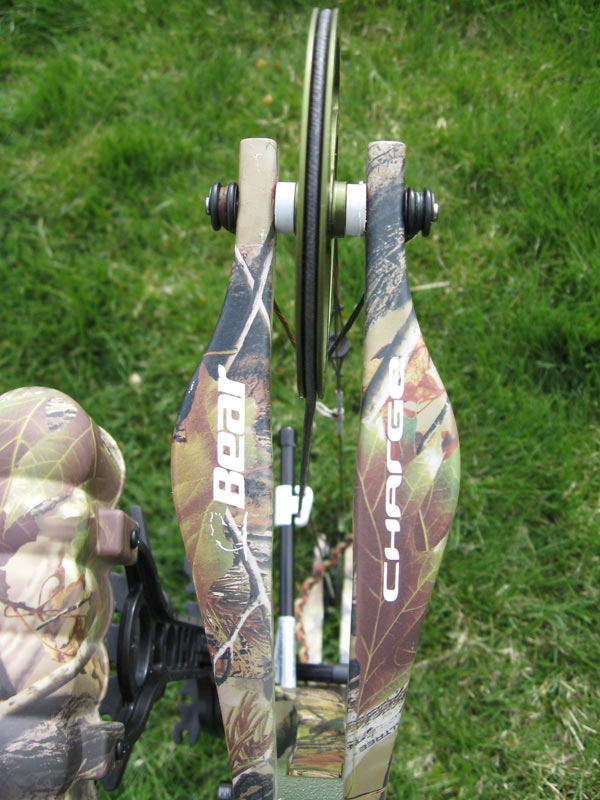By Bob Robb
I remember when the first split-limb bows appeared back in the 1980s — before the technology was refined. Archers weren’t impressed, and the design fell away for a decade.
Today, split-limb bows are back in a big way. Still, questions remain: Why do we need split-limb bows? And, are they as strong, reliable and accurate as solid-limb bows?
Historical Perspective

In the old days, solid-limb designs sometimes cracked after repeated flexing. This problem was a result of how they were made.
Generally, limbs are fabricated of a laminated material which is stronger along the length of the limb than across it. For greatest flexing strength, the limb is made up of incremental strips which run the length of the limb from its point of attachment at the riser to the end receiving the pulley axle. Adjacent strips are typically held together with adhesives, and the limb is covered by a reinforcing laminate.
The strips at the outer edges of the limb run the entire length of the limb and directly receive the flexing stress when the bow is drawn. However, strips located in the middle of the limb terminate somewhere along the limb crotch. These interior strips do not directly receive the flexing force and have a tendency to resist flexing as the bow is drawn. Only the interstrip cohesive forces transfer stress to the interior strips from the outer strips.
Since the interfiber cohesive forces are not as strong as the strips themselves, the interior strips do not receive as much longitudinal stress as the outer strips. As a result, the limb has a tendency to develop significant transverse tensional stresses, which concentrate at the area where the crotch is deepest. After repeated flexing, the concentrated transverse tensional stresses eventually tend to overcome the cohesive forces and cause separation of adjacent strips. A crack can develop near the end of the crotch.
Another problem experienced by conventional compound bows is the torsional stress exerted on the bow limb by the pulleys. The stress can cause the bow limbs to be pulled out of vertical alignment with the riser and each other. If the bow limbs are not properly aligned, the bow will not shoot straight.
Prior methods for preventing the limb from splitting included applying a reinforcing patch near the bottom of the crotch, installing a bolt or rivet beneath the crotch, and using a harness yoke for the dead-end connection of the bus cables attached to the bow pulleys to achieve uniform stress distribution across the limb.
However, none of these methods completely eliminates the potential cracking of bow limbs. In addition, the use of reinforcing bolts or patches increases the weight of the bow limb and reduces the bow limb acceleration.
Inception of the Split
The first patent for a split-limb compound bow (Caldwell U.S. Pat. No. 4,350,138) was issued to Joseph M. Caldwell in 1980 and disclosed a forked bow limb that was split axially for a substantial portion of the length of the limb.
The split divided the limb into two portions held together by means such as a bracket at a point inboard of the crotch. When the bow is drawn, the limb portions flex together essentially as though the limb were unsplit along its length. The bracket, however, interferes with the flexing of the limb along its entire length. Also, the bow limb members are not separate and independent and thus remain subject to splitting.
As time went on other innovators continued to explore the potential of split limbs, and on March 3, 1998, patent number 5,722,380 was issued to Spencer Land and Clint Pierce of High Country Archery. These designs became the basis of modern split-limb technology.
Split for Strength
Fast forward to today. Controlled stress tests on bow limbs show that some solid limbs can begin to fail after about 25 dry fires. Most often, they start to crack where the V-groove is where the cam is mounted. Cracks sometimes also occur where the limb mounts to the riser.
For comparison, Hoyt (a company that offers an array of split-limb compound bows) has engineered a patented ¾-inch Split Limb Technology to survive an amazing 1,000 dry fires at 80 pounds draw weight and 30-inch draw length. The design also eliminates the V-groove and limb bolt groove or hole where failure most often occurs on traditional solid limbs.
Does all this mean that solid limb bows are on their way to the scrap heap?
Of course not. Modern solid-limb compounds are more reliable, fast and accurate than ever before. What it does show is that modern split-limb bows are extremely tough, durable, fast and accurate, too.
Bob Robb is a professional outdoor writer and accomplished whitetail bow-hunter from Arizona.
